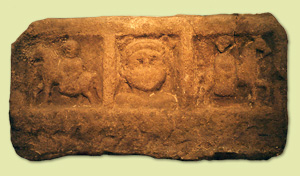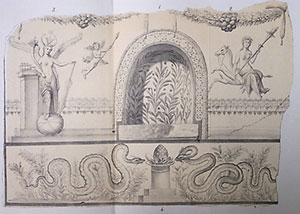Deities Associated with Epona
Co-depictions
Mercury
Epona is depicted - twice! - on a relief from Strasbourg (Bas-Rhin, Alsace, France), flanking a central head of Mercury [Espérandieu #7297, Forrer p. 236]. We see here a link between the Gaulish association of Roman Mercury with commerce and travelling, and the non-military association of Epona with travelling.
Isis
A wall painting from Pompei (Campana, Italy) shows, to the right, a sidesaddle Epona and, to the left, Isis, recognisable from her sistrum and headdress. Each goddess carries a cornucopia, and both are naked to the waist. This wall painting no longer exists, and is known only from an engraving [Jordan].
Although described as an Epona by Jordan, the mounted figure may be in fact a Nereid seated on a hippocamp, inaccurately recorded in the engraving; the item carried is also more like a Dionysian thyrsus than a cornucopia.
Epona and Isis are further connected by literary references: The Octavius, by Minucius Felix and The Golden Ass, by Apuleius.
Co-dedications
Of the 66 inscriptions that mention Epona by name, 33 mention only Epona and the other 33 also mention other deities. The following table lists the frequency of other deity names in those inscriptions.
| Deity | Number |
|---|---|
| Jupiter Optimus Maximus | 14 |
| Campestres | 13 |
| Mars | 13 |
| Minerva | 12 |
| Silvanus | 12 |
| Victoria | 12 |
| Apollo | 11 |
| Diana | 11 |
| Juno | 11 |
| Mercurius | 11 |
| Hercules | 10 |
| Matres | 10 |
| Domus Divinae | 7 |
| Fortuna | 6 |
| Divine Augustus | 2 |
| Genius Loci | 2 |
| Asclepius | 1 |
| Hermes | 1 |
As expected, the Capitoline Triad of Jupiter, Juno and Minerva, who shared a temple on the Capitoline Hill in Rome [Adkins 1998], figure prominently. Most of the others are common Roman deities, although a few stand out. The Campestres, in second place, were goddesses of the parade ground, originally Germanic, and worshipped primarily by the Germanic horse guard of the Emperor – the Equites Singulares Augusti [Irby-Massie, Speidel p.139]. This fits well with Epona as a horse goddess, although why both the Campestres and Epona were worshipped at the same time remains to be discussed - presumably they had different functions. The Matres or Mothers were a trio of mother goddesses, again from Germany. Nine of the ten are Matres Suleviae [Speidel p.141], a Celtic name (meaning the good drivers) [Delmarre p.239] for a Germanic goddess.
Silvanus, a typical if minor Roman deity, is prominent; Silvanus had an especial popularity and a distinct local character as chief god of Nature in the Roman province of Pannonia [Rendić-Mioċević], which was a recruiting ground of the Equites Singulares Augusti from the reign of Septimus Severus onwards [Speidel p.57-60] .
There are seven loyal dedications to the divine house (of the emperor), two to the divine spirit of the emperor (the Augustus) and two to the spirit of place (Genius Locus). The dedication (in Latin) to Hermes (the Greek deity who became the Roman Mercury) is unusual, and occurs on the same inscription as that to Asclepius, the Greek god of healing [Adkins 1996 p.21]; the fact that the spelling is closer to the Greek (Άσχληπιός, Asklepios) than the conventional Roman spelling (Aesculapius) [Hornblower p.29] and the use of the Greek name Hermes indicates that the dedicant was most likely a Greek medic or veterinarian serving with the Roman army.
Outside Rome
Given the large number of deities listed on the Epona inscriptions at the fort of the Equites Singulares Augusti in Rome [Speidel p.139-145], it is instructive to look at the remaining codedication frequencies when inscriptions from the city of Rome are excluded. There remain 54 Epona inscriptions, of which more than half (31) mention only Epona.
| Deity outside Rome | Number |
|---|---|
| Domus Divinae | 7 |
| Jupiter Optimus Maximus | 3 |
| Campestres | 3 |
| Hercules | 3 |
| Mars | 2 |
| Divine Augustus | 2 |
| Genius Loci | 2 |
| Minerva | 1 |
| Silvanus | 1 |
| Victoria | 1 |
| Matres | 1 |
| Asclepius | 1 |
| Hermes | 1 |
This shows that in the city of Rome, Epona inscriptions commonly include a large number of other deity names whereas outside Rome the number of associated deities is greatly reduced. This is probably because the Equites Singulares Augustii dominate the dedications from the city of Rome itself, and form a distinct and atypical group of worshippers.
References
Adkins, L. and R. Adkins (1996). Dictionary of Roman Religion. New York; Oxford, Oxford University Press.
Adkins, L. and R. Adkins (1998). Handbook to life in ancient Rome. New York; Oxford, Oxford University Press.
Delamarre, X. (2001). Dictionnaire de la Langue Gauloise. Paris, Editions Errance.
Espérandieu, É. (1907). Recueil général des bas-reliefs de la Gaule romaine. Paris, Imprimerie nationale.
Forrer, R. (1924) Nouvelles découvertes et acquisitions Anzeiger, n° 57-60, décembre 1924
Hornblower, S. and A. Spaworth (2003) The Oxford Classical Dictionary, Third Revised Edition; Oxford University Press, Oxford.
Irby-Massie, G. L. (1996). "The Roman Army and the Cult of the Campestres." Zeitschrift für Papyrologie und Epigraphik 113: 293-300.
Jordan, H. (1872). De genii et Eponae picturis pompeianis nuper detectis. Romae, typis Salviucci.
Rendić-Mioċević, A. Š., M. (1988). Religions and Cults in South Pannonian Regions. Religions and Cults in Pannonia. F. Jenő. Székesfehérvár, Museums of County Fejér.
Speidel, M. P. (1994). Riding for Caesar: the Roman Emperors' Horse Guards. Cambridge, Massachusetts, Harvard University Press.


